Professional Practice: Event Planning, Problem Solving & CPD Plan
VerifiedAdded on 2024/05/21
|30
|3757
|421
Report
AI Summary
This report provides a comprehensive overview of professional practice, focusing on the design and delivery of a training event. It explores various communication styles and formats, emphasizing effective time management skills in event planning. The report delves into problem-solving techniques and the application of critical reasoning to solutions. Team dynamics are analyzed, highlighting the roles of group members and their effectiveness in achieving shared goals. Furthermore, the importance of Continuing Professional Development (CPD) is discussed, along with the creation of a development plan outlining responsibilities, performance objectives, and required skills for future goals. The document concludes by comparing motivational theories and their impact on workplace performance, offering a thorough evaluation of evidence criteria for effective CPD. Desklib provides access to this and other solved assignments.
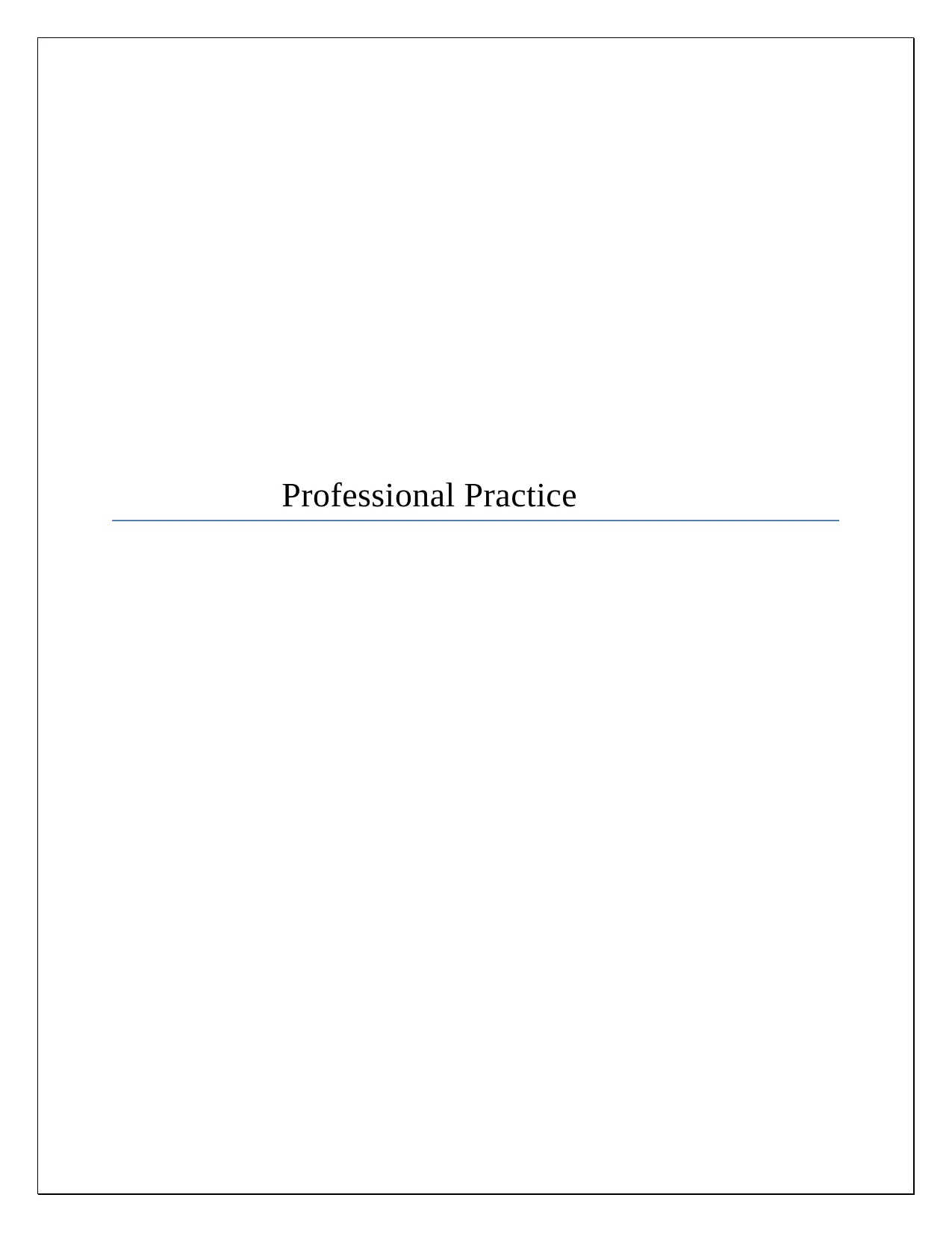
Professional Practice
Paraphrase This Document
Need a fresh take? Get an instant paraphrase of this document with our AI Paraphraser
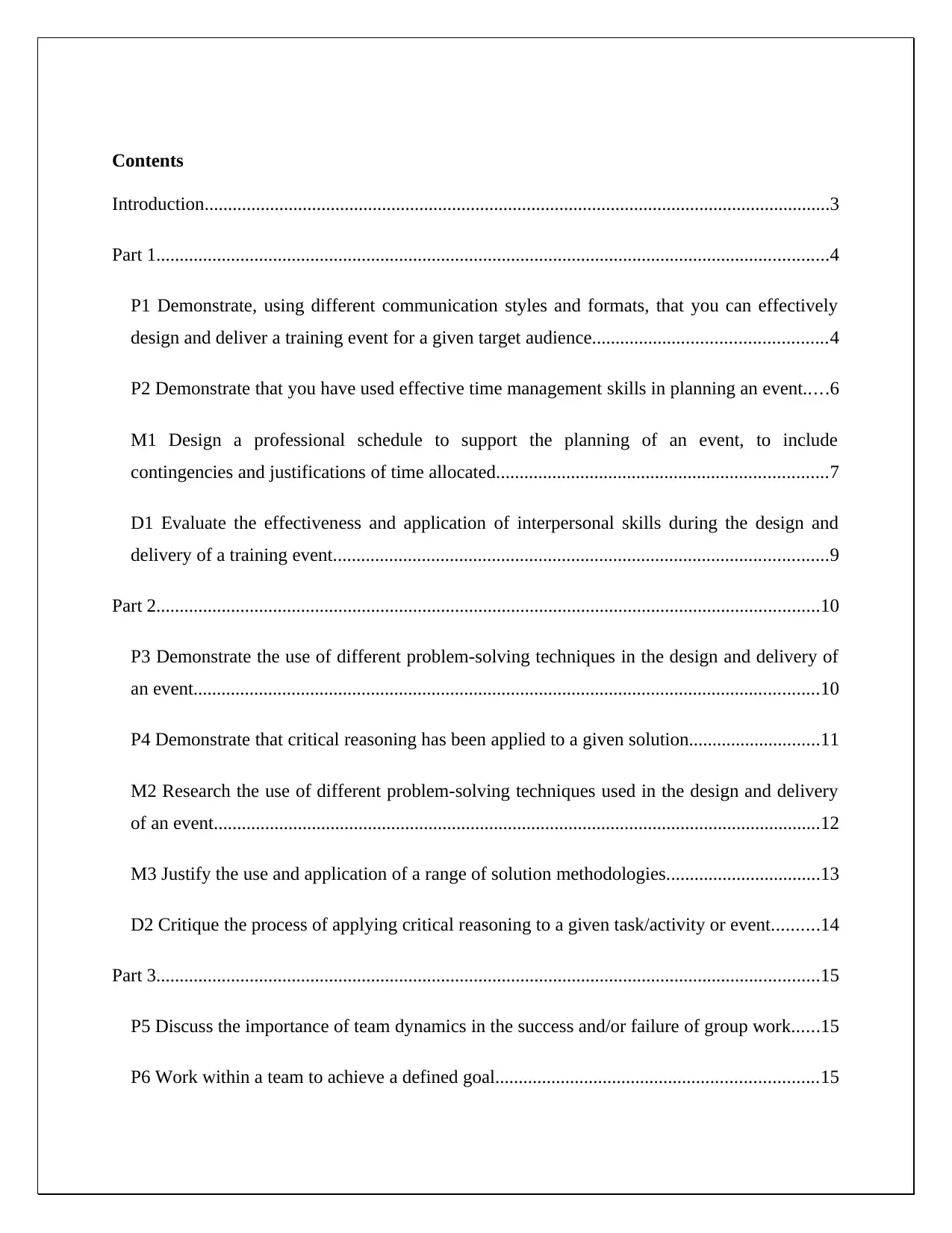
Contents
Introduction......................................................................................................................................3
Part 1................................................................................................................................................4
P1 Demonstrate, using different communication styles and formats, that you can effectively
design and deliver a training event for a given target audience..................................................4
P2 Demonstrate that you have used effective time management skills in planning an event.....6
M1 Design a professional schedule to support the planning of an event, to include
contingencies and justifications of time allocated.......................................................................7
D1 Evaluate the effectiveness and application of interpersonal skills during the design and
delivery of a training event..........................................................................................................9
Part 2..............................................................................................................................................10
P3 Demonstrate the use of different problem-solving techniques in the design and delivery of
an event......................................................................................................................................10
P4 Demonstrate that critical reasoning has been applied to a given solution............................11
M2 Research the use of different problem-solving techniques used in the design and delivery
of an event..................................................................................................................................12
M3 Justify the use and application of a range of solution methodologies.................................13
D2 Critique the process of applying critical reasoning to a given task/activity or event..........14
Part 3..............................................................................................................................................15
P5 Discuss the importance of team dynamics in the success and/or failure of group work......15
P6 Work within a team to achieve a defined goal.....................................................................15
Introduction......................................................................................................................................3
Part 1................................................................................................................................................4
P1 Demonstrate, using different communication styles and formats, that you can effectively
design and deliver a training event for a given target audience..................................................4
P2 Demonstrate that you have used effective time management skills in planning an event.....6
M1 Design a professional schedule to support the planning of an event, to include
contingencies and justifications of time allocated.......................................................................7
D1 Evaluate the effectiveness and application of interpersonal skills during the design and
delivery of a training event..........................................................................................................9
Part 2..............................................................................................................................................10
P3 Demonstrate the use of different problem-solving techniques in the design and delivery of
an event......................................................................................................................................10
P4 Demonstrate that critical reasoning has been applied to a given solution............................11
M2 Research the use of different problem-solving techniques used in the design and delivery
of an event..................................................................................................................................12
M3 Justify the use and application of a range of solution methodologies.................................13
D2 Critique the process of applying critical reasoning to a given task/activity or event..........14
Part 3..............................................................................................................................................15
P5 Discuss the importance of team dynamics in the success and/or failure of group work......15
P6 Work within a team to achieve a defined goal.....................................................................15
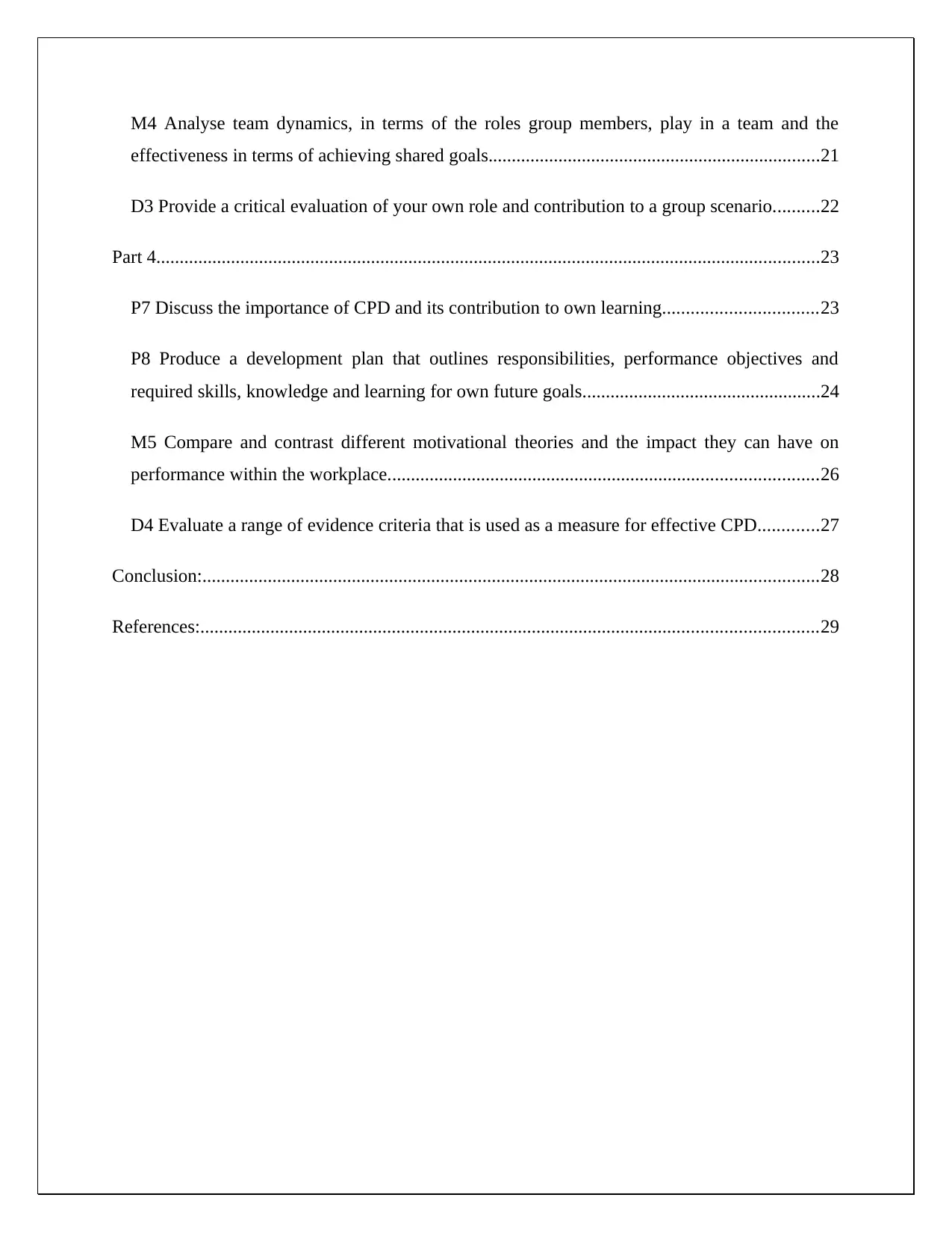
M4 Analyse team dynamics, in terms of the roles group members, play in a team and the
effectiveness in terms of achieving shared goals.......................................................................21
D3 Provide a critical evaluation of your own role and contribution to a group scenario..........22
Part 4..............................................................................................................................................23
P7 Discuss the importance of CPD and its contribution to own learning.................................23
P8 Produce a development plan that outlines responsibilities, performance objectives and
required skills, knowledge and learning for own future goals...................................................24
M5 Compare and contrast different motivational theories and the impact they can have on
performance within the workplace............................................................................................26
D4 Evaluate a range of evidence criteria that is used as a measure for effective CPD.............27
Conclusion:....................................................................................................................................28
References:....................................................................................................................................29
effectiveness in terms of achieving shared goals.......................................................................21
D3 Provide a critical evaluation of your own role and contribution to a group scenario..........22
Part 4..............................................................................................................................................23
P7 Discuss the importance of CPD and its contribution to own learning.................................23
P8 Produce a development plan that outlines responsibilities, performance objectives and
required skills, knowledge and learning for own future goals...................................................24
M5 Compare and contrast different motivational theories and the impact they can have on
performance within the workplace............................................................................................26
D4 Evaluate a range of evidence criteria that is used as a measure for effective CPD.............27
Conclusion:....................................................................................................................................28
References:....................................................................................................................................29
⊘ This is a preview!⊘
Do you want full access?
Subscribe today to unlock all pages.

Trusted by 1+ million students worldwide
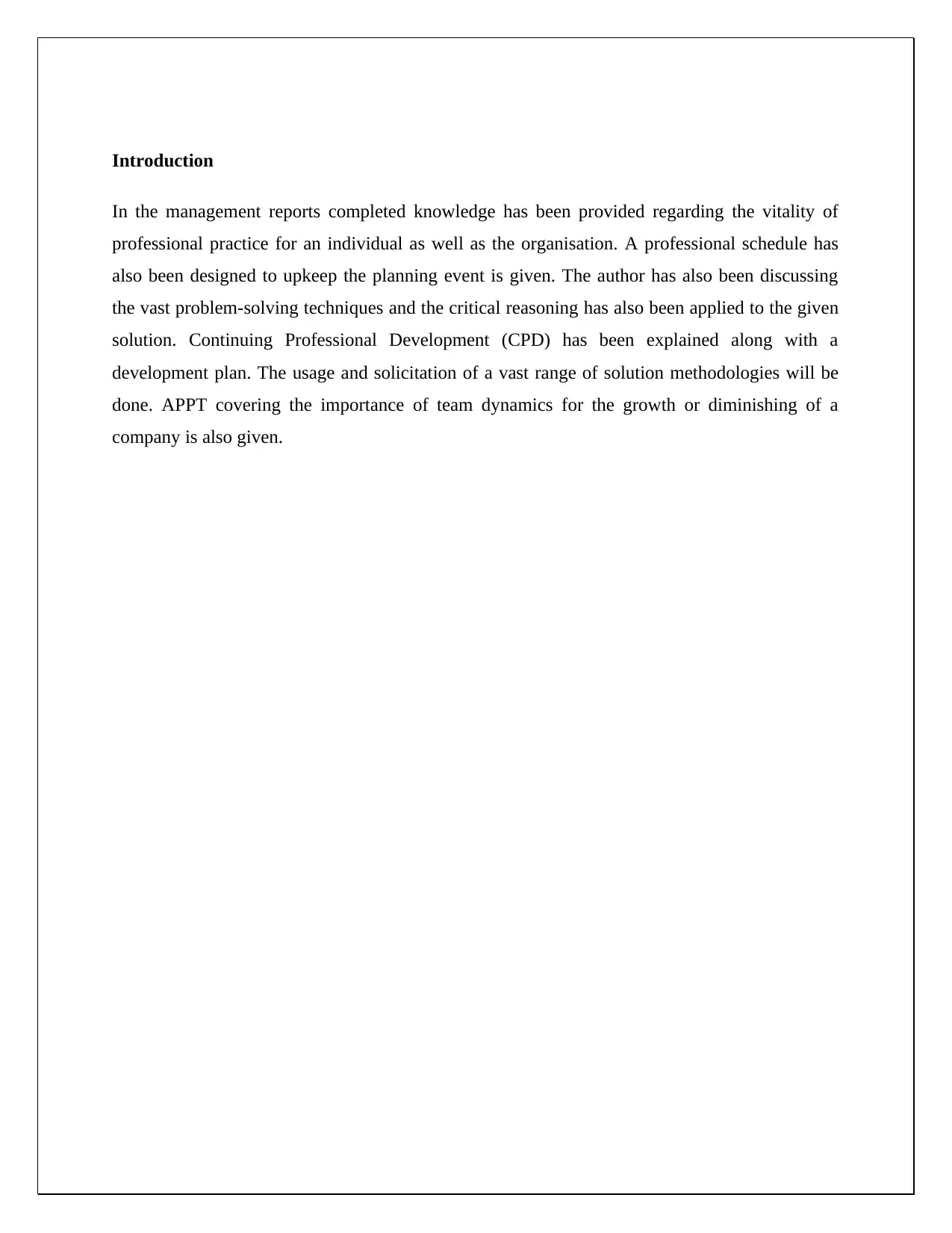
Introduction
In the management reports completed knowledge has been provided regarding the vitality of
professional practice for an individual as well as the organisation. A professional schedule has
also been designed to upkeep the planning event is given. The author has also been discussing
the vast problem-solving techniques and the critical reasoning has also been applied to the given
solution. Continuing Professional Development (CPD) has been explained along with a
development plan. The usage and solicitation of a vast range of solution methodologies will be
done. APPT covering the importance of team dynamics for the growth or diminishing of a
company is also given.
In the management reports completed knowledge has been provided regarding the vitality of
professional practice for an individual as well as the organisation. A professional schedule has
also been designed to upkeep the planning event is given. The author has also been discussing
the vast problem-solving techniques and the critical reasoning has also been applied to the given
solution. Continuing Professional Development (CPD) has been explained along with a
development plan. The usage and solicitation of a vast range of solution methodologies will be
done. APPT covering the importance of team dynamics for the growth or diminishing of a
company is also given.
Paraphrase This Document
Need a fresh take? Get an instant paraphrase of this document with our AI Paraphraser
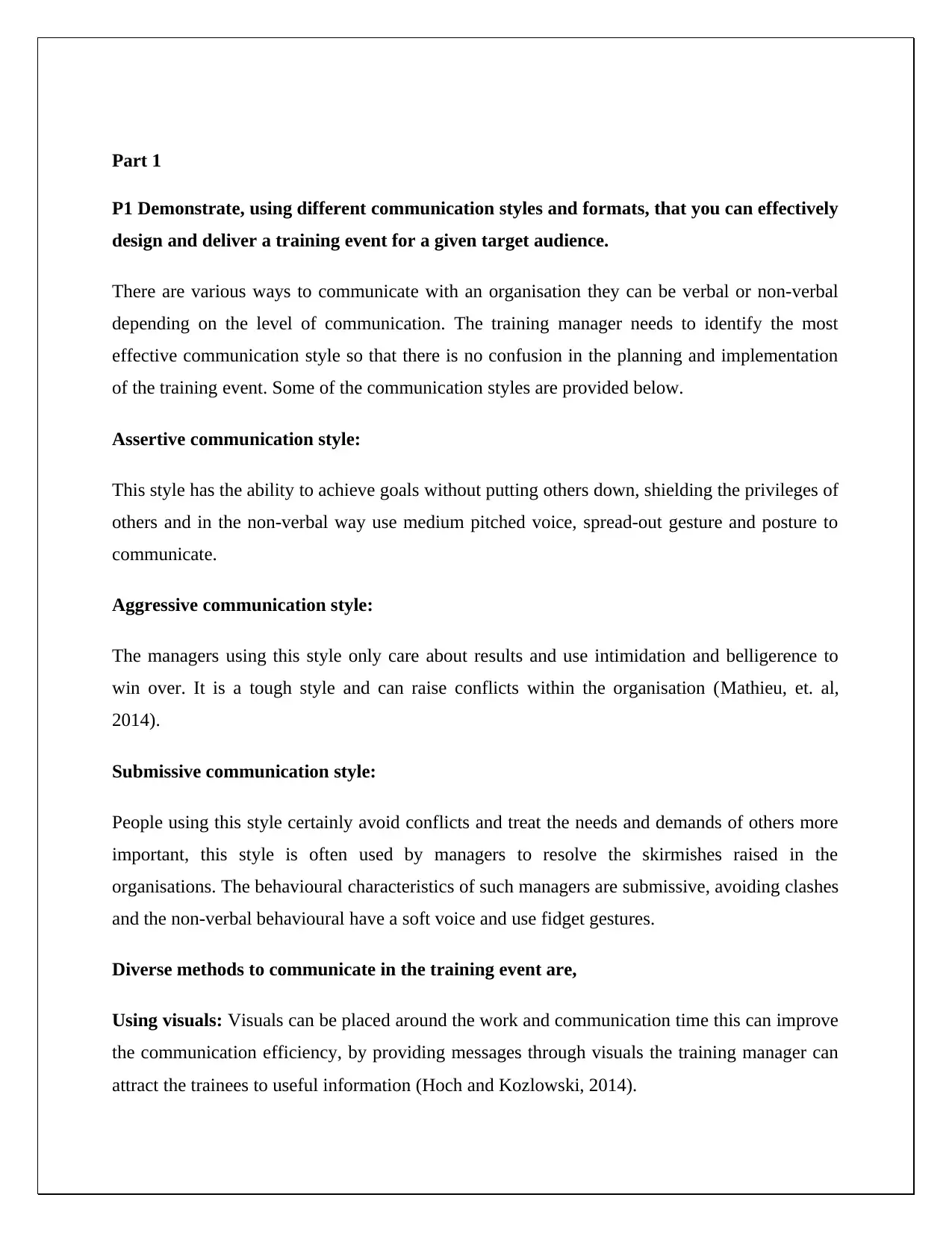
Part 1
P1 Demonstrate, using different communication styles and formats, that you can effectively
design and deliver a training event for a given target audience.
There are various ways to communicate with an organisation they can be verbal or non-verbal
depending on the level of communication. The training manager needs to identify the most
effective communication style so that there is no confusion in the planning and implementation
of the training event. Some of the communication styles are provided below.
Assertive communication style:
This style has the ability to achieve goals without putting others down, shielding the privileges of
others and in the non-verbal way use medium pitched voice, spread-out gesture and posture to
communicate.
Aggressive communication style:
The managers using this style only care about results and use intimidation and belligerence to
win over. It is a tough style and can raise conflicts within the organisation (Mathieu, et. al,
2014).
Submissive communication style:
People using this style certainly avoid conflicts and treat the needs and demands of others more
important, this style is often used by managers to resolve the skirmishes raised in the
organisations. The behavioural characteristics of such managers are submissive, avoiding clashes
and the non-verbal behavioural have a soft voice and use fidget gestures.
Diverse methods to communicate in the training event are,
Using visuals: Visuals can be placed around the work and communication time this can improve
the communication efficiency, by providing messages through visuals the training manager can
attract the trainees to useful information (Hoch and Kozlowski, 2014).
P1 Demonstrate, using different communication styles and formats, that you can effectively
design and deliver a training event for a given target audience.
There are various ways to communicate with an organisation they can be verbal or non-verbal
depending on the level of communication. The training manager needs to identify the most
effective communication style so that there is no confusion in the planning and implementation
of the training event. Some of the communication styles are provided below.
Assertive communication style:
This style has the ability to achieve goals without putting others down, shielding the privileges of
others and in the non-verbal way use medium pitched voice, spread-out gesture and posture to
communicate.
Aggressive communication style:
The managers using this style only care about results and use intimidation and belligerence to
win over. It is a tough style and can raise conflicts within the organisation (Mathieu, et. al,
2014).
Submissive communication style:
People using this style certainly avoid conflicts and treat the needs and demands of others more
important, this style is often used by managers to resolve the skirmishes raised in the
organisations. The behavioural characteristics of such managers are submissive, avoiding clashes
and the non-verbal behavioural have a soft voice and use fidget gestures.
Diverse methods to communicate in the training event are,
Using visuals: Visuals can be placed around the work and communication time this can improve
the communication efficiency, by providing messages through visuals the training manager can
attract the trainees to useful information (Hoch and Kozlowski, 2014).
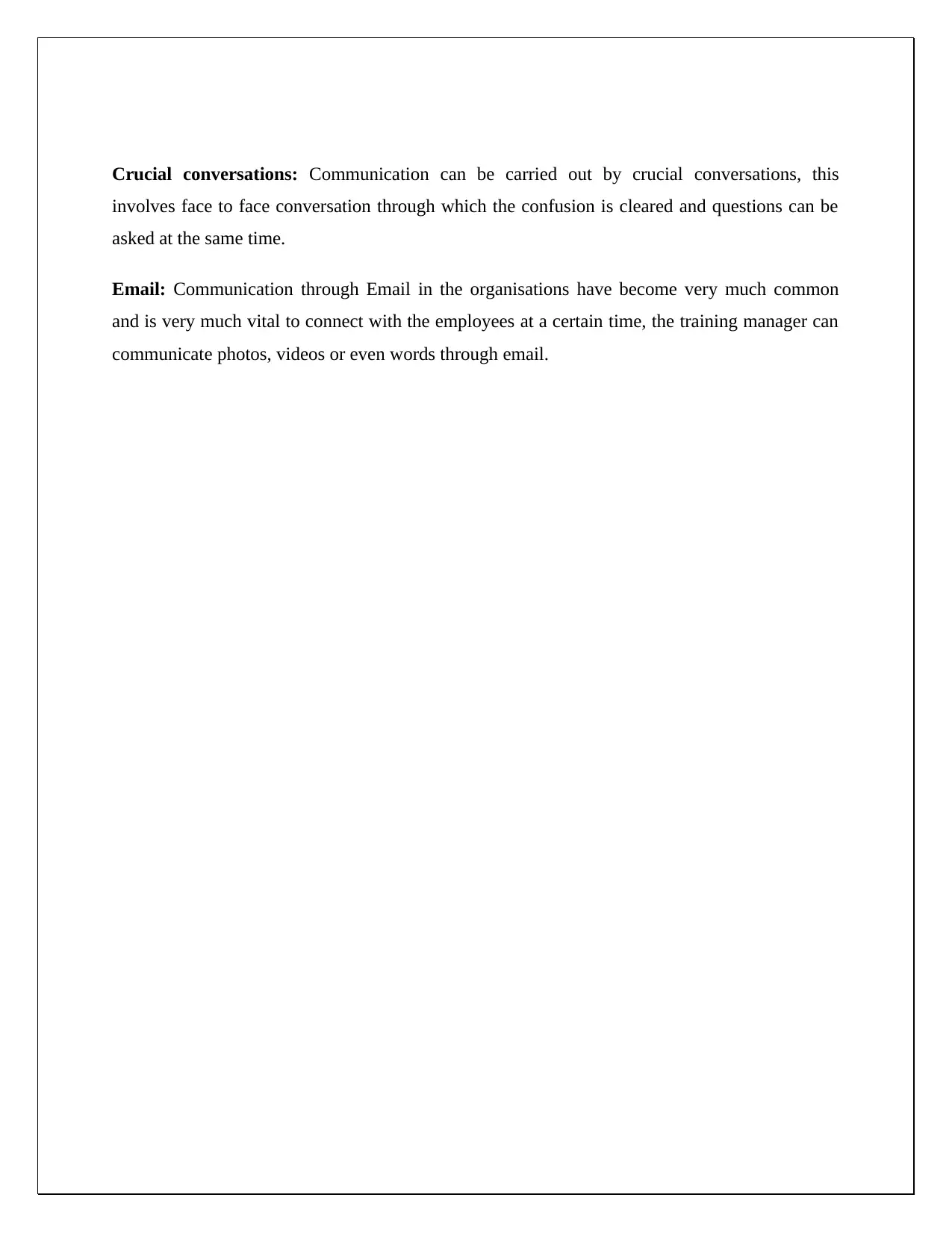
Crucial conversations: Communication can be carried out by crucial conversations, this
involves face to face conversation through which the confusion is cleared and questions can be
asked at the same time.
Email: Communication through Email in the organisations have become very much common
and is very much vital to connect with the employees at a certain time, the training manager can
communicate photos, videos or even words through email.
involves face to face conversation through which the confusion is cleared and questions can be
asked at the same time.
Email: Communication through Email in the organisations have become very much common
and is very much vital to connect with the employees at a certain time, the training manager can
communicate photos, videos or even words through email.
⊘ This is a preview!⊘
Do you want full access?
Subscribe today to unlock all pages.

Trusted by 1+ million students worldwide
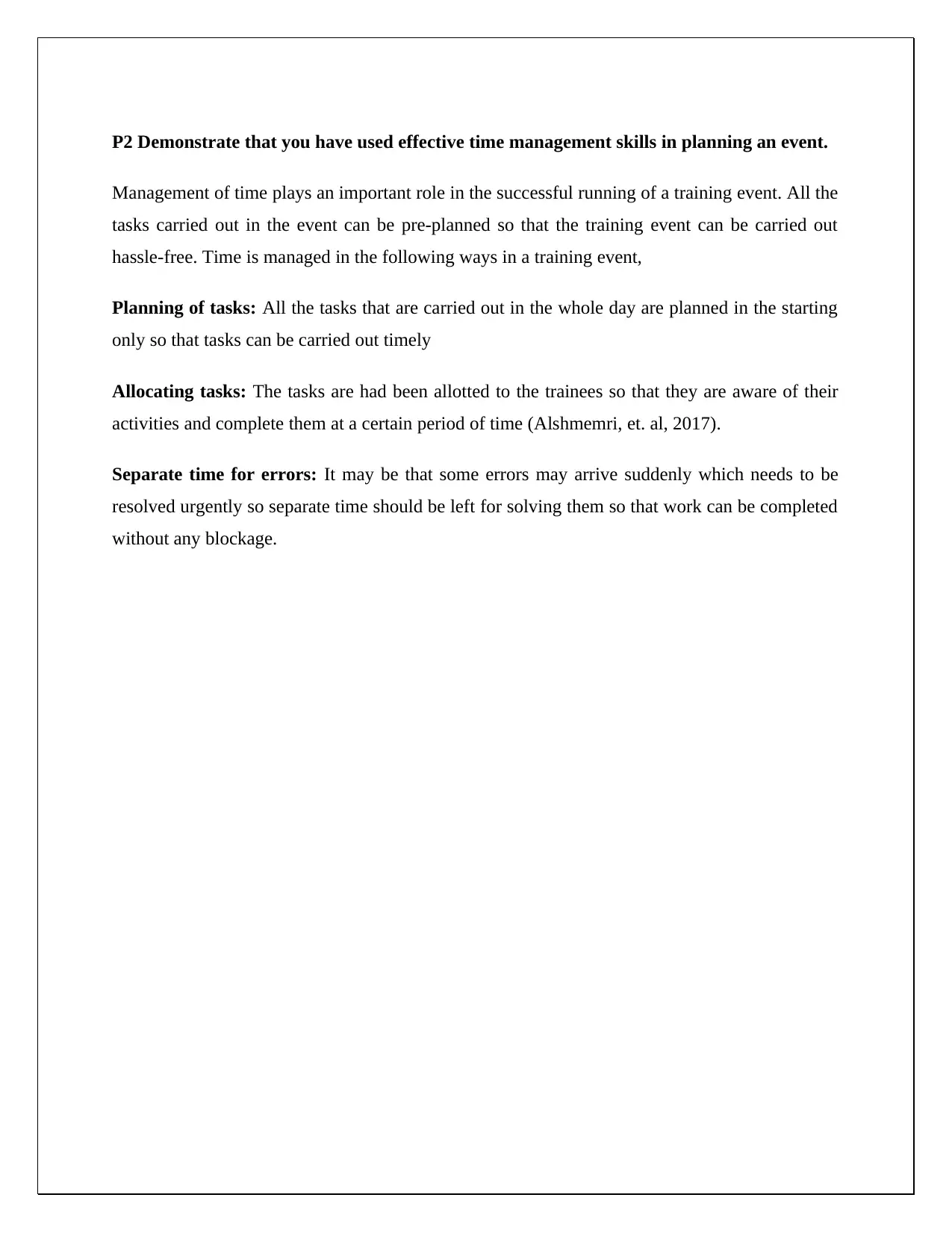
P2 Demonstrate that you have used effective time management skills in planning an event.
Management of time plays an important role in the successful running of a training event. All the
tasks carried out in the event can be pre-planned so that the training event can be carried out
hassle-free. Time is managed in the following ways in a training event,
Planning of tasks: All the tasks that are carried out in the whole day are planned in the starting
only so that tasks can be carried out timely
Allocating tasks: The tasks are had been allotted to the trainees so that they are aware of their
activities and complete them at a certain period of time (Alshmemri, et. al, 2017).
Separate time for errors: It may be that some errors may arrive suddenly which needs to be
resolved urgently so separate time should be left for solving them so that work can be completed
without any blockage.
Management of time plays an important role in the successful running of a training event. All the
tasks carried out in the event can be pre-planned so that the training event can be carried out
hassle-free. Time is managed in the following ways in a training event,
Planning of tasks: All the tasks that are carried out in the whole day are planned in the starting
only so that tasks can be carried out timely
Allocating tasks: The tasks are had been allotted to the trainees so that they are aware of their
activities and complete them at a certain period of time (Alshmemri, et. al, 2017).
Separate time for errors: It may be that some errors may arrive suddenly which needs to be
resolved urgently so separate time should be left for solving them so that work can be completed
without any blockage.
Paraphrase This Document
Need a fresh take? Get an instant paraphrase of this document with our AI Paraphraser
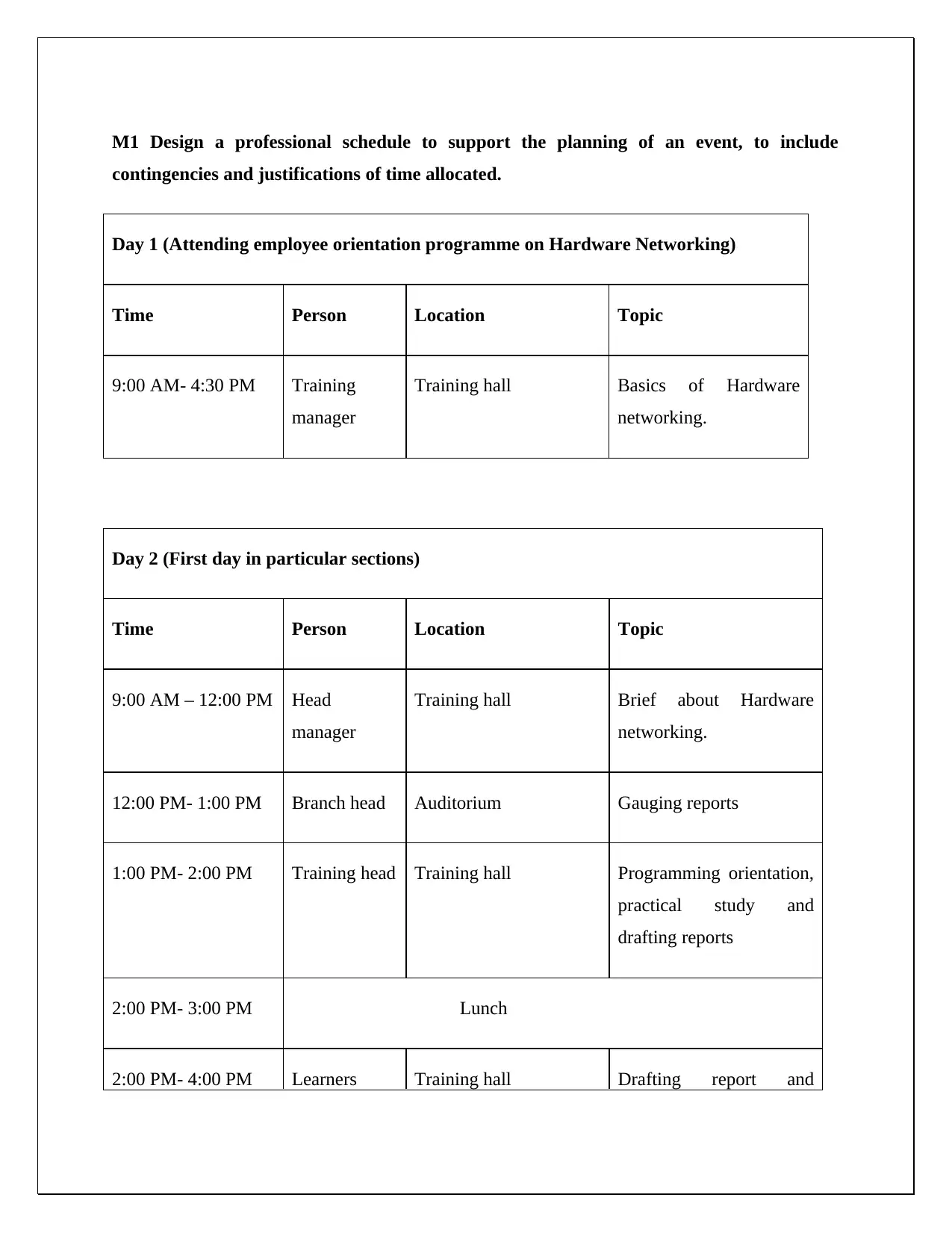
M1 Design a professional schedule to support the planning of an event, to include
contingencies and justifications of time allocated.
Day 1 (Attending employee orientation programme on Hardware Networking)
Time Person Location Topic
9:00 AM- 4:30 PM Training
manager
Training hall Basics of Hardware
networking.
Day 2 (First day in particular sections)
Time Person Location Topic
9:00 AM – 12:00 PM Head
manager
Training hall Brief about Hardware
networking.
12:00 PM- 1:00 PM Branch head Auditorium Gauging reports
1:00 PM- 2:00 PM Training head Training hall Programming orientation,
practical study and
drafting reports
2:00 PM- 3:00 PM Lunch
2:00 PM- 4:00 PM Learners Training hall Drafting report and
contingencies and justifications of time allocated.
Day 1 (Attending employee orientation programme on Hardware Networking)
Time Person Location Topic
9:00 AM- 4:30 PM Training
manager
Training hall Basics of Hardware
networking.
Day 2 (First day in particular sections)
Time Person Location Topic
9:00 AM – 12:00 PM Head
manager
Training hall Brief about Hardware
networking.
12:00 PM- 1:00 PM Branch head Auditorium Gauging reports
1:00 PM- 2:00 PM Training head Training hall Programming orientation,
practical study and
drafting reports
2:00 PM- 3:00 PM Lunch
2:00 PM- 4:00 PM Learners Training hall Drafting report and
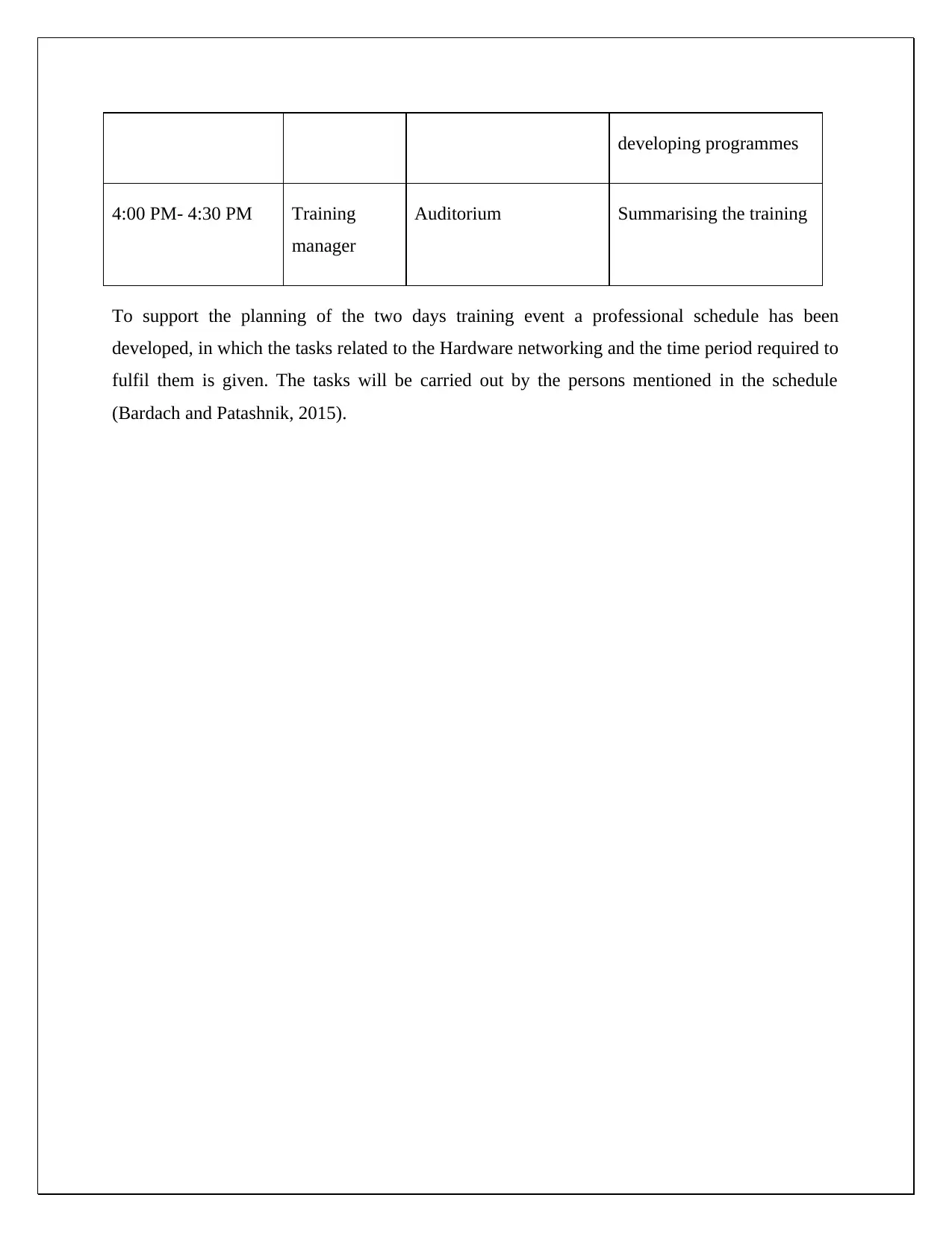
developing programmes
4:00 PM- 4:30 PM Training
manager
Auditorium Summarising the training
To support the planning of the two days training event a professional schedule has been
developed, in which the tasks related to the Hardware networking and the time period required to
fulfil them is given. The tasks will be carried out by the persons mentioned in the schedule
(Bardach and Patashnik, 2015).
4:00 PM- 4:30 PM Training
manager
Auditorium Summarising the training
To support the planning of the two days training event a professional schedule has been
developed, in which the tasks related to the Hardware networking and the time period required to
fulfil them is given. The tasks will be carried out by the persons mentioned in the schedule
(Bardach and Patashnik, 2015).
⊘ This is a preview!⊘
Do you want full access?
Subscribe today to unlock all pages.

Trusted by 1+ million students worldwide
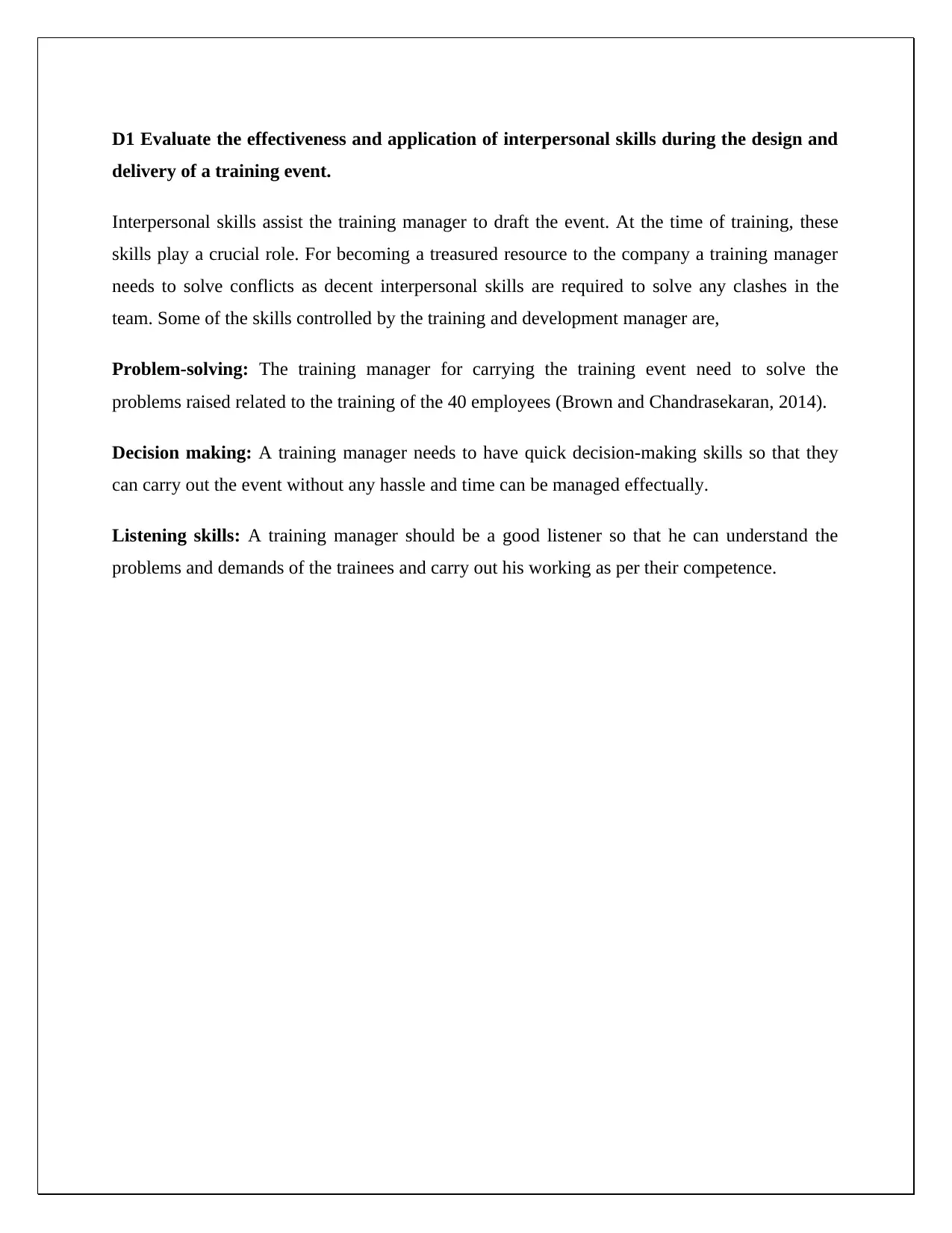
D1 Evaluate the effectiveness and application of interpersonal skills during the design and
delivery of a training event.
Interpersonal skills assist the training manager to draft the event. At the time of training, these
skills play a crucial role. For becoming a treasured resource to the company a training manager
needs to solve conflicts as decent interpersonal skills are required to solve any clashes in the
team. Some of the skills controlled by the training and development manager are,
Problem-solving: The training manager for carrying the training event need to solve the
problems raised related to the training of the 40 employees (Brown and Chandrasekaran, 2014).
Decision making: A training manager needs to have quick decision-making skills so that they
can carry out the event without any hassle and time can be managed effectually.
Listening skills: A training manager should be a good listener so that he can understand the
problems and demands of the trainees and carry out his working as per their competence.
delivery of a training event.
Interpersonal skills assist the training manager to draft the event. At the time of training, these
skills play a crucial role. For becoming a treasured resource to the company a training manager
needs to solve conflicts as decent interpersonal skills are required to solve any clashes in the
team. Some of the skills controlled by the training and development manager are,
Problem-solving: The training manager for carrying the training event need to solve the
problems raised related to the training of the 40 employees (Brown and Chandrasekaran, 2014).
Decision making: A training manager needs to have quick decision-making skills so that they
can carry out the event without any hassle and time can be managed effectually.
Listening skills: A training manager should be a good listener so that he can understand the
problems and demands of the trainees and carry out his working as per their competence.
Paraphrase This Document
Need a fresh take? Get an instant paraphrase of this document with our AI Paraphraser
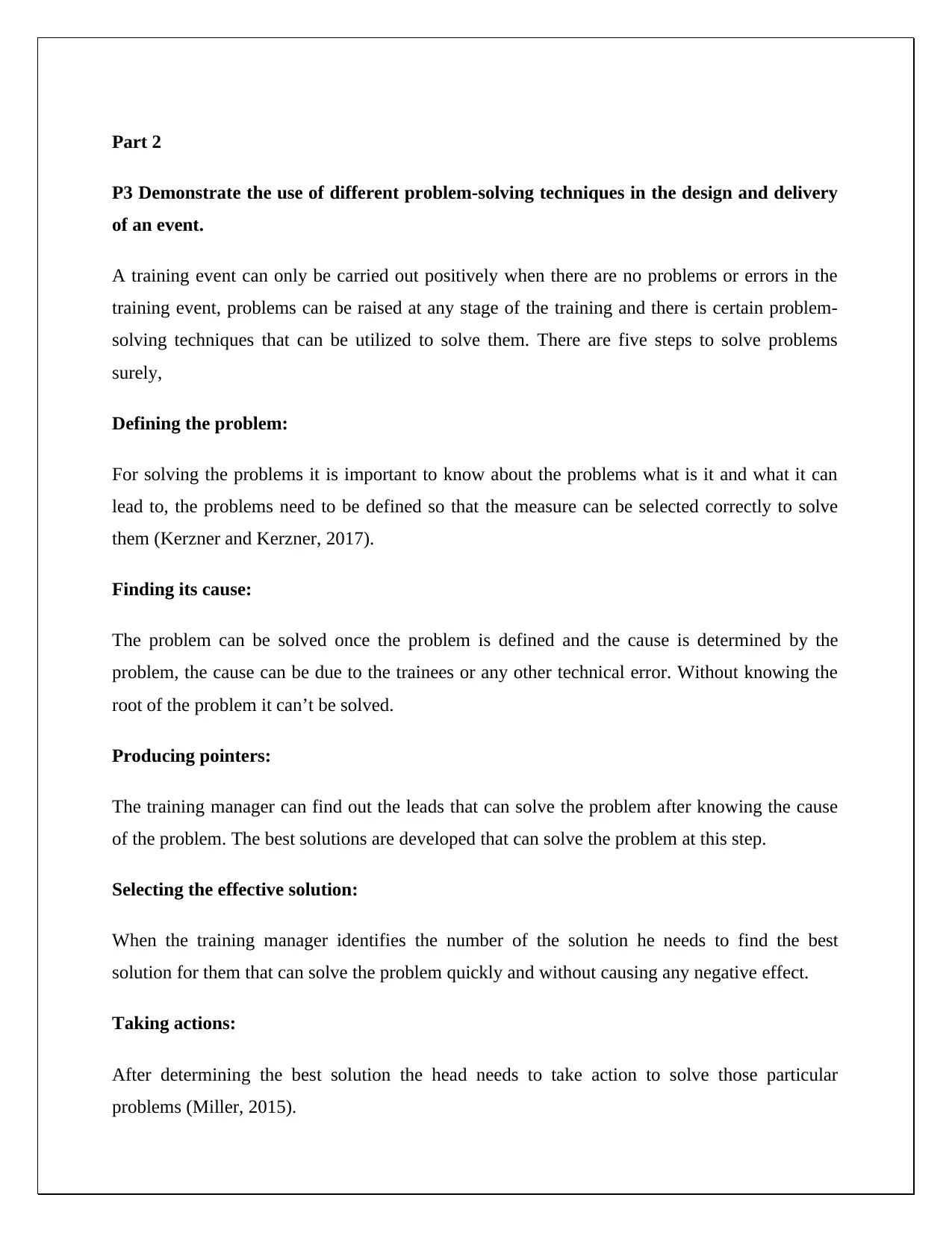
Part 2
P3 Demonstrate the use of different problem-solving techniques in the design and delivery
of an event.
A training event can only be carried out positively when there are no problems or errors in the
training event, problems can be raised at any stage of the training and there is certain problem-
solving techniques that can be utilized to solve them. There are five steps to solve problems
surely,
Defining the problem:
For solving the problems it is important to know about the problems what is it and what it can
lead to, the problems need to be defined so that the measure can be selected correctly to solve
them (Kerzner and Kerzner, 2017).
Finding its cause:
The problem can be solved once the problem is defined and the cause is determined by the
problem, the cause can be due to the trainees or any other technical error. Without knowing the
root of the problem it can’t be solved.
Producing pointers:
The training manager can find out the leads that can solve the problem after knowing the cause
of the problem. The best solutions are developed that can solve the problem at this step.
Selecting the effective solution:
When the training manager identifies the number of the solution he needs to find the best
solution for them that can solve the problem quickly and without causing any negative effect.
Taking actions:
After determining the best solution the head needs to take action to solve those particular
problems (Miller, 2015).
P3 Demonstrate the use of different problem-solving techniques in the design and delivery
of an event.
A training event can only be carried out positively when there are no problems or errors in the
training event, problems can be raised at any stage of the training and there is certain problem-
solving techniques that can be utilized to solve them. There are five steps to solve problems
surely,
Defining the problem:
For solving the problems it is important to know about the problems what is it and what it can
lead to, the problems need to be defined so that the measure can be selected correctly to solve
them (Kerzner and Kerzner, 2017).
Finding its cause:
The problem can be solved once the problem is defined and the cause is determined by the
problem, the cause can be due to the trainees or any other technical error. Without knowing the
root of the problem it can’t be solved.
Producing pointers:
The training manager can find out the leads that can solve the problem after knowing the cause
of the problem. The best solutions are developed that can solve the problem at this step.
Selecting the effective solution:
When the training manager identifies the number of the solution he needs to find the best
solution for them that can solve the problem quickly and without causing any negative effect.
Taking actions:
After determining the best solution the head needs to take action to solve those particular
problems (Miller, 2015).

P4 Demonstrate that critical reasoning has been applied to a given solution.
The problem-solving techniques that are used by the training manager were as per the principals
of management. The ideas of the techniques were generated by the senior members of the team.
The training manager critically measured the tools and techniques that were involved in solving
the conflicts raised in the training manager. Reasons for the clashes were studied and conflicts
were solved. Necessary steps were taken to avoid any future chances of the errors. There are few
meetings of the training and development manager with the trainees where the ideas and the
tactics to solve the struggles are discussed and the best possible technique are used (Robertson,
2016).
The problem-solving techniques that are used by the training manager were as per the principals
of management. The ideas of the techniques were generated by the senior members of the team.
The training manager critically measured the tools and techniques that were involved in solving
the conflicts raised in the training manager. Reasons for the clashes were studied and conflicts
were solved. Necessary steps were taken to avoid any future chances of the errors. There are few
meetings of the training and development manager with the trainees where the ideas and the
tactics to solve the struggles are discussed and the best possible technique are used (Robertson,
2016).
⊘ This is a preview!⊘
Do you want full access?
Subscribe today to unlock all pages.

Trusted by 1+ million students worldwide
1 out of 30
Related Documents
Your All-in-One AI-Powered Toolkit for Academic Success.
+13062052269
info@desklib.com
Available 24*7 on WhatsApp / Email
![[object Object]](/_next/static/media/star-bottom.7253800d.svg)
Unlock your academic potential
Copyright © 2020–2025 A2Z Services. All Rights Reserved. Developed and managed by ZUCOL.



